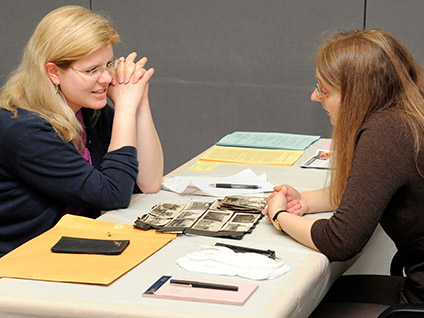
Treating Memories as Documents
Spring 2015, Vol. 47, No. 1 | Your Family Archives
By Mary Lynn Ritzenthaler
Almost everyone has treasured family papers and documents that record events in their own lives and the lives of their ancestors. These papers can take many forms and their condition can vary greatly, depending on how the paper was made (poor-quality newsprint vs. strong paper used for handwritten letters or typescript) as well as how it has been stored and handled.
Your goal: Do no harm and help ensure preservation for future generations.
Here are a few tips:
Storage: Avoid storing paper in hot attics or damp basements or garages; cool and dry conditions are best. Damp conditions can encourage the growth of mold and can attract insects. If it’s too hot, paper can dry out and become brittle.
Handling: To avoid causing tears and breaks, handle all paper documents gently with two hands. Make sure hands are clean (no lotions that could leave stains). Avoid food and drink around your treasured items. Open folded letters and newspapers with care. Do not back-fold to flatten them (which can cause paper to break at folds lines). Stop if your efforts seem to be causing damage. Do not mend documents with any kind of glue or tape. Do not fold, cut, or trim original documents.
Housing: Place paper documents in good quality folders and boxes that are large enough to fully enclose and support them. Avoid using acidic cardboard boxes. Polyester sleeves can protect individual documents that are weak or brittle. Large items, such as maps and drawings, should be stored flat, if possible. Smaller items, such as letters or diplomas, can be stored upright in folders and boxes.
Display: Inks, markers, colored papers, and watercolors can all fade if overly exposed to light. All types of light will cause damage, with sunlight and fluorescent light being the quickest to cause changes. To protect paper documents from light damage, store them in the dark and limit long-term display of the original. The best way to avoid damage is to display a copy. Print a digital scan for display purposes.
Sharing: Use scans to share information with other family members. To help ensure that original documents are not damaged during scanning, use a scanner with a glass platen larger than the items; do not use auto feed. To help ensure long-term access to electronic versions of scanned documents, store files on the hard drive of your computer (not on compact discs) and have other family members keep back-up copies.
We will explore these topics, and others, in more detail in future columns.
Find more information on this topic at www.archives.gov/preservation.
Mary Lynn Ritzenthaler is chief of the National Archives Conservation Laboratory.
